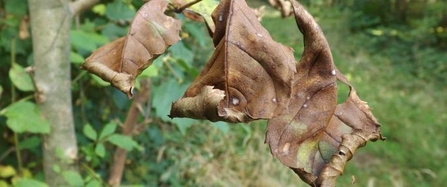
Tree showing signs of ash dieback. Credit Steve Collin Norfolk Wildlife Trust

Tree showing signs of ash dieback. Credit Steve Collin Norfolk Wildlife Trust
Nottinghamshire Wildlife Trust, which is currently marking its 60th Anniversary, has highlighted the challenges it faces in balancing the needs of wildlife and people ahead of tree safety work at several of its nature reserves in the Newark & Sherwood area - triggered by the presence of Ash dieback disease.
Symptoms of Ash dieback include blackening of leaves, discoloured stems, and dead branches and trees may eventually drop limbs, collapse, or fall. Once a tree is infected the disease is usually fatal, either directly, or indirectly by weakening the tree to the point where it succumbs to other pests or pathogens, such as honey fungus.
It is anticipated that up to 80% of ash trees across the UK could be lost to the disease. It has also been estimated that the total cost to the UK economy could be as much as £15 billion, with over £7 billion cost by 2030.
With no cure for ash dieback available, Nottinghamshire Wildlife Trust, which manages dozens of nature reserves across the county including many large woodlands, faces a huge challenge in protecting wildlife whilst ensuring that its sites are safe for visitors.
Following a series of surveys and safety inspections, the charity plans to tackle the disease at three of its sites, Beacon Hill Conservation Park, off Beacon Hill Road Newark, Ploughman Wood, between Lowdham and Woodborough and Duke’s Wood at Eakring – ahead of the bird nesting season.
Over the past 12 months we’ve been revising our approach to tackling ash dieback to ensure that we are only removing trees where it is essential to ensure the safety of people and property.Wayne Ball, Head of Nature Recovery (South)Nottinghamshire Wildlife Trust
Speaking about the planned work, Head of Nature Recovery (South) Wayne Ball said: “Over the past 12 months we’ve been revising our approach to tackling ash dieback to ensure that we are only removing trees where it is essential to ensure the safety of people and property. Our focus is on preserving as much habitat as possible, but we also need to keep visitors safe and reduce the risk of trees falling on neighbouring property.”
To reduce the number of trees that need to be felled, the Trust has decided to close a small number of paths within some woodlands. Explaining the decision, Wayne added: “We are committed to protecting and restoring wildlife whilst ensuring people have opportunities to access nature on their doorstep. Our nature reserves are a unique resource where people can see, hear and enjoy wildlife free of charge – but to limit the impact of a potentially devastating disease we’ve made the difficult decision to close a small number of paths. The alternative would be to clear large numbers of trees along both sides of these routes causing unacceptable impact on wildlife.”
Whilst the Trust has no choice but to tackle ash dieback, it is also focussing on opportunities to enhance the biodiversity value of affected nature reserves. Wayne added: “By proactively leaving affected trees where we can safely do so, we will be adding to the valuable deadwood habitat and avoiding unnecessary disturbance. Where we have to fell ash, we will either replant with different native species or encourage natural regeneration of trees and shrubs.”
With over 40 nature reserves across the county, the charity also faces the added challenge of covering the significant cost of specialist surveys and tree safety inspections, tree felling and replanting. Wayne explained: “The problem of ash dieback is here to stay and is really taking a hold across our nature reserves. Specialist survey, felling contractors, replanting and signage all cost money on top of our long-term conservation management. The extra cost could run to tens of thousands of pounds a year for the foreseeable future. This is one of the reasons we’ve refined our approach to look for ways to safely reduce the number of trees we must fell and reduce associated costs. With the support of our members and donors and the understanding of visitors we will rise to the challenges presented by this disease.”
The disease, a fatal fungal disease of ash trees, was first confirmed in the UK in 2012, also known as ‘Chalara’ is caused by a fungus called Hymenoscyphus fraxineus. The disease has spread quickly and now affects woodlands across the UK, causing the death of thousands of trees. It has already caused widespread damage across Europe.
References